Realizing a low-carbon society requires the concerted efforts of both the energy supply and demand sides. TEPCO contributes to creating a low-carbon society by simultaneously producing low-CO2 electricity and promoting electrification through the use of various high-efficiency electric products.
All-electric systems use electricity produced from non-fossil energy sources and high-efficiency power generation facilities to operate high-efficiency electric products. Compared to systems that directly burn fossil fuels (combustion system), all-electric systems minimize fossil fuel consumption and contribute to reducing CO2 emissions. TEPCO promotes electrification in many sectors including the residential, industrial, commercial, and transportation sectors and encourages the use of heat pumps and electric vehicles to lower carbon levels throughout society.
Comparison of heat pumps and combustion air conditioning systems (in the case of heating)
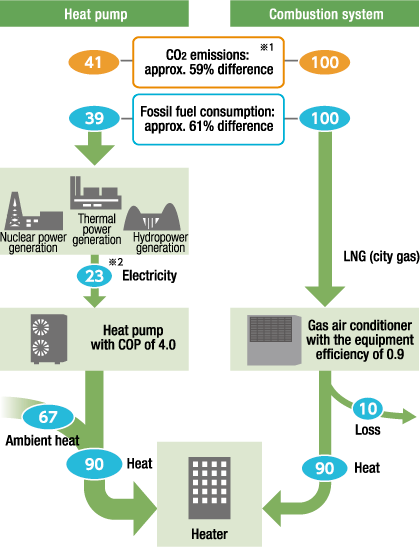
Heat pumps require only a small amount of electricity to gather ambient heat, which is an inexhaustible natural energy source as are sunlight and wind power. But they produce about 3 to 6 times greater heat energy than the electric energy they use. Heat pumps' high environmental performance and efficiency are indispensable to realizing a low-carbon society.
If all air conditioners and water heaters in the consumer sector (residential and commercial) and industrial sector are replaced with those powered by heat pumps, an estimated approx. 140 million tons of yearly CO2 emissions could be reduced in Japan (consumer sector:approx.100 million tons, industrial sector:approx.40 million tons). This amount is corresponding to roughly 10% of total CO2 emissions in Japan.
Mechanism of heat pumps
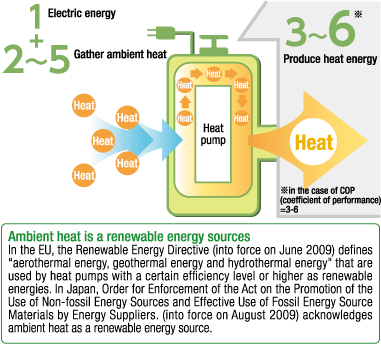
CO2 reduction potential of heat pumps
(Supposing all air conditioners, water heaters, heating/drying appliances (including those that generate high temperatures over 100℃), and agricultural appliances are replaced with those powered by heat pumps)
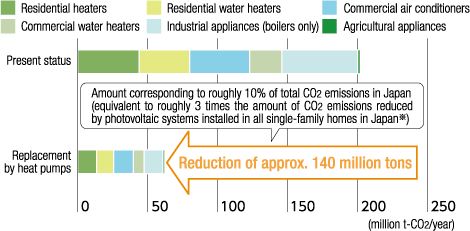
* TEPCO estimation based on photovoltaic system capacity: 4 kW; facility utilization rate: 12%;
number of single-family homes in Japan: 27.45 million homes (Ministry of Internal Affairs and Communications Statistics Bureau, “2008 Housing and Land Survey”) .Source: Estimates by Heat Pump and Thermal Storage Technology Center of Japan
Recent advancements made in technical development have greatly improved heat pump performance. For instance, the COP (coefficient of performance) of residential air conditioners has improved roughly 2-fold in 10 years, and the COP of residential Eco Cute water heaters almost 1.5-fold compared to 2001, the year they were released.
There is growing expectation of heat pumps as the key to energy saving and CO2 reduction, as is also evident in the government's "The New Growth Strategy Blueprint for Revitalizing Japan" (cabinet decision in June 2010), which aims to turn homes, offices, etc. into zero-emission structures through the spread of eco-housing, heat pumps, etc. as a strategy for becoming an environment and energy power through "green innovation".
Heat pump COP (coefficient of performance)
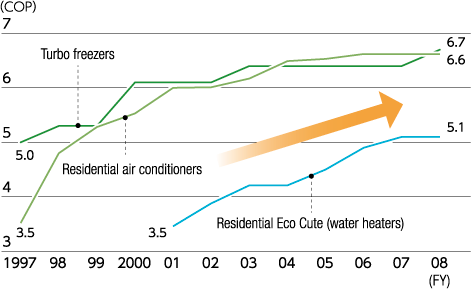 Source: The Energy Conservation Center, Japan; The Japan Refrigeration and Air Conditioning Industry Association; manufacturers' catalogs
Source: The Energy Conservation Center, Japan; The Japan Refrigeration and Air Conditioning Industry Association; manufacturers' catalogs
Some representative examples of items in our immediate surrounding that use heat pumps are air conditioners, water heaters, and refrigerators. However, in addition to such items in the residential sector, heat pumps are also used widely in the industrial and commercial sectors, as well as in the agricultural sector.
To further spread the use of high-efficiency heat pumps, we are working in close cooperation with product manufacturers in developing diverse products that offer outstanding environmental performance and economic efficiency in response to customer needs and disseminating them.
Heat pump applications in various sectors 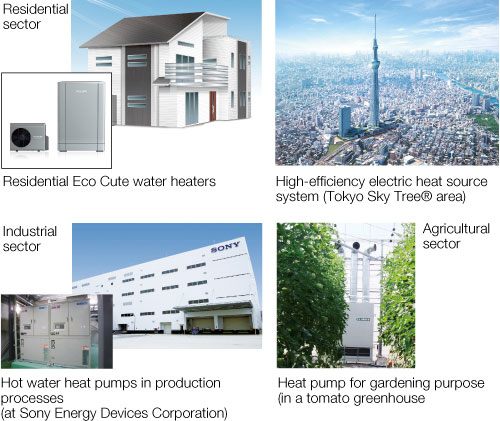
The industrial sector is responsible for a large 34% of total CO2 emission in Japan, but emissions from households and offices have increased significantly compared to 1990, the base year of the Kyoto Protocol, so that effective countermeasures are also urgently sought in these two sectors, toward realizing a low-carbon society.
CO2 emissions in Japan Breakdown of sector (FY2008)
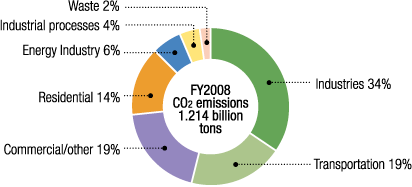 Source: Based on the Ministry of the Environment website
Source: Based on the Ministry of the Environment website
Changes in CO2 emissions by sector, compared to the FY1990 level
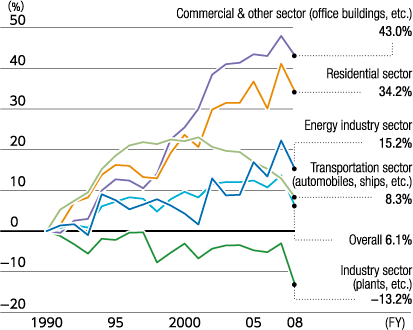 Source: Based on National Institute for Environmental Studies website
Source: Based on National Institute for Environmental Studies website
© Tokyo Electric Power Company Holdings, Inc.